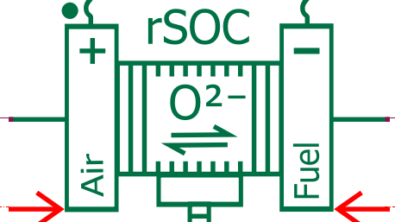Drone noise: an inconvenient truth?
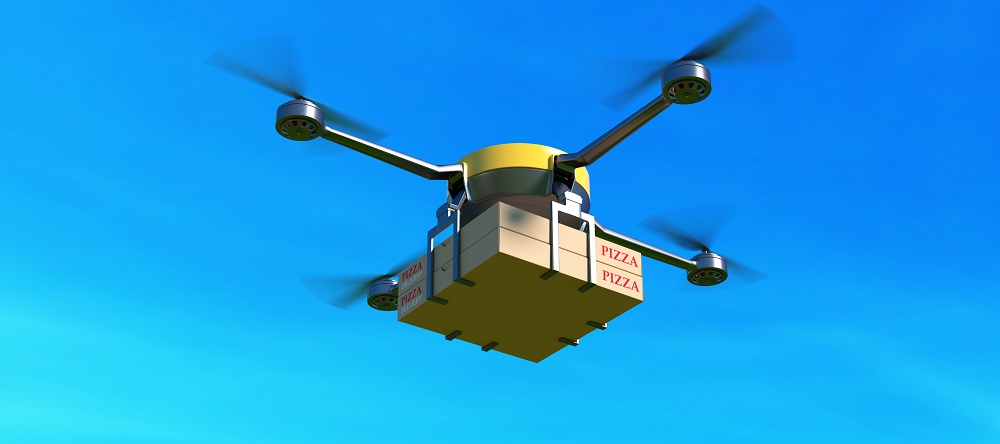
A recent study by Levitate Capital predicts the total drone sector to grow from around 15 billion dollars last year to over 90 billion by 2030. To achieve this, the logistics segment, of which delivery is an essential share, should evolve from almost non-existent to a business worth 33 billion dollars – the largest of all. Drone noise can destroy this outlook. And Simcenter 3D Acoustics can help prevent this from happening. In this blog, we’ll illustrate how.
How suddenly a peaceful suburb Down Under got divided
Imagine how beautiful life can be if food and household necessities can be delivered to your home right when you need them, no matter how far you live from any city center. Drone delivery seems to make this dream come true. No more parcels getting delayed in traffic. No more isolation because of natural obstacles like water or mountains. And no courier cost. So it can be cheaper than anything else. Drones seem to have everything to become the next big thing in last-mile delivery.
But all that glitters is not gold. Nev Sheather doesn’t tweak his words when he tells Siemens about his experience:
‘A high-pitched whining sound all day long; like an angry, screaming lawnmower above our heads. People desperately leaving their homes during weekends, just to escape from the irritation caused by drone noise. Distressed wildlife, especially birds. Dogs barking all day. And the social cohesion in the neighborhood being completely destroyed.’
Sheather is spokesman of Bonython Against Drones, a community action group, formed in August 2018. That was just one month after ‘Project Wing’ started, a trial with delivery drones in their township of Bonython, southern Canberra. Very quickly, the story of the disgruntled residents started to get traction, first in Australian press and politics. And ultimately, even the Wall Street Journal was talking about drone noise.
That some random unhappy Australian citizens made it to American newspapers is remarkable. But at the same time, not a complete surprise. When Project Wing started, Google was in charge of it. Later, the program led to the founding of the company Wing, a subsidiary of Google’s parent Alphabet. That one became the first drone-based parcel delivery company ever to receive an air operator’s certificate from the United States Federal Aviation Administration (FAA) in April 2019.
Bonython Against… euhm… Drones. But why?
So, who are these people? How can anyone be “against drones”? Are these just bored people who like to get a bit of attention? Check out the video in the tweet below and decide for yourself:
Sheather clarifies: ‘We don’t have anything against technology. In fact, we don’t even have anything against drones! We just think it’s not okay to have them deliver coffee and burritos to individuals while at the same time seriously bothering over 200 others along their flight path.’
Sheather is not alone. Just 4 months after the group was formed, they handed over a petition to the Australian Capital Territory (ACT) assembly, calling on parliamentarians to stop all future household drone deliveries in the capital. It was signed by over 1000 people. A door knock action would have indicated that no less than 80% of the Bonython residents were upset with the drones. Some people were even openly telling the police that they would shoot them out of the sky if they could.
‘Emotions ran high,’ Sheather confirms. ‘And they still do it. We never asked to be part of this, and still, it messed up our lives and left our community deeply divided. Drones are intrusive. At first, we were concerned about safety and privacy. But then came the noise. That sharp, annoying drone noise.’
Is an emergent market at risk because of drone noise?
Being an engineering company that specializes in acoustics, Sheather’s story obviously intrigues us. How did things come this far? Will drone noise put wide adoption of the technology for this application at stake? What does this mean for that spectacular business outlook Levitate Capital predicts? And, should we be surprised?
Yes and no.
Drone noise: an underrated problem
Yes, it is surprising that concerns about drone noise came to the surface in this harsh and unanticipated manner. Anything that runs on propellers, moves air and generates turbulence, will make noise. You don’t have to be an acoustics mastermind to figure out that it will have a very tonal nature and that it will most probably sound annoying.
Still, more people seem to underrate the problem. Scanning through some research materials, drone noise is always around but never the leading concern.
McKinsey, for example, studied how consumers see advanced air mobility (AAM), even focusing specifically on delivery drones. When asking people for their main concern, they rank safety and privacy higher than noise.
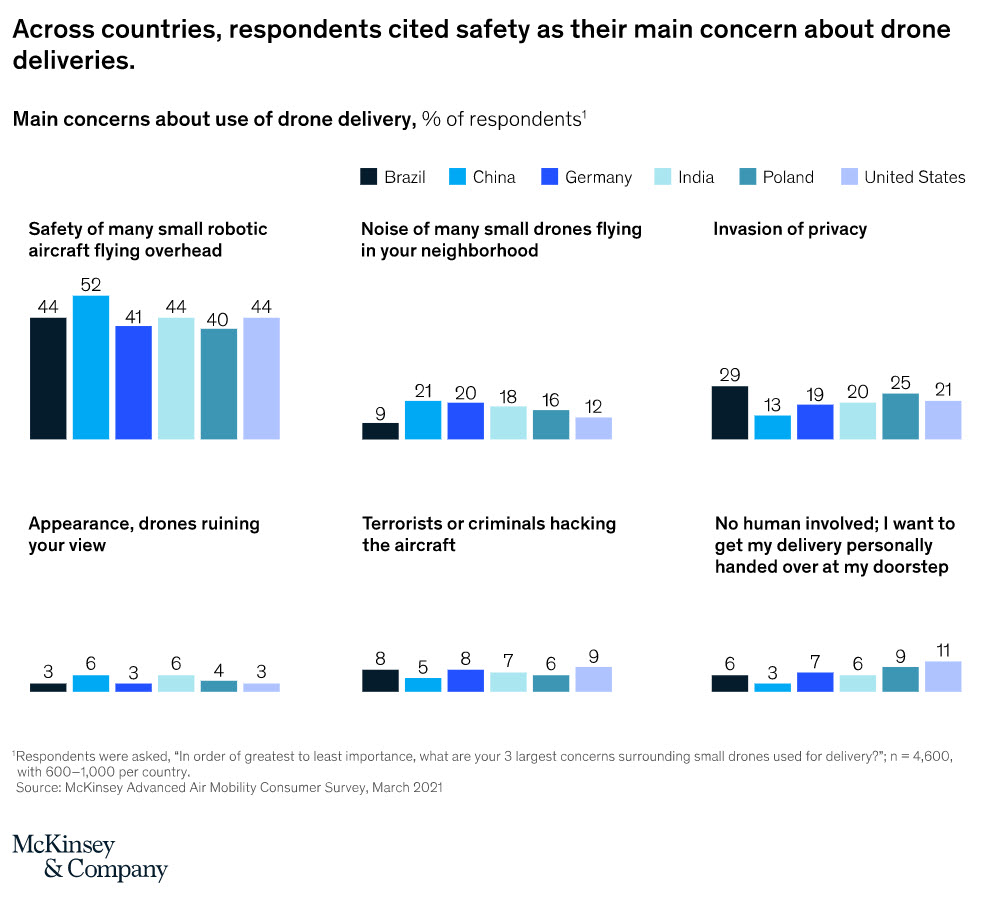
Studies by the British Royal Aeronautical Society and in the Aeronautical Journal of the Council of European Aerospace Societies (CEAS) show similar results.
How is this possible? Are people confusing high-power commercial drones with some of those light hobby drones they know about? Are delivery companies so blinded by the dizzying market potential that they prefer to shuffle drone noise under the table, like an inconvenient truth?
In this way, people won’t accept
Whatever it is, what we read in those publications is not what Wing found out the hard way in Bonython.
After the trial, they gathered feedback from 119 residents, resulting in 60% positive and 40% negative responses. Not quite the 80% opponents as reported by Sheather’s group after the door knock action; the truth will probably be somewhere in the middle. But still, not really dream numbers when endeavoring wide adoption.
And most importantly: 91% of the negative feedback was related to noise (see graph), which confirms it isn’t exactly a secondary concern.
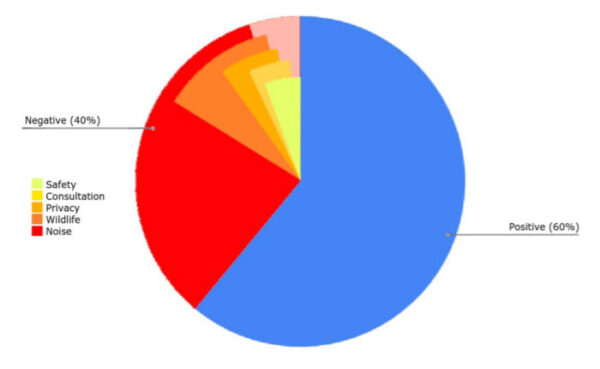
That is a problem. With such public resistance, drone delivery won’t happen. If drone noise isn’t urgently tackled (along with other concerns), a 33 billion dollars business potential is indeed at risk.
What’s so specific about drone noise then?
Despite missing adequate (public) attention, drone noise has been on the agenda extensively during recent years among acoustics experts. Logical, as it does indeed seem to have certain specific characteristics that annoy us. More than typical traffic noises such as cars, trucks, and vans.
NASA demonstrated this in a study with psychoacoustic tests. And, remarkably: they found that different recordings of the same drone, but at various altitudes, sound equally annoying, despite differences of several decibels (dB). This could mean that no matter how silent or loud a drone is, there will always be something in the sound that upsets us. NASA even concluded by predicting that drone delivery operators would likely face opposition because of noise. That was one year before the trial in Bonython started.
Current research focuses on better understanding this annoyance and expressing it in appropriate metrics. Also, studies on the impact of drone noise on the environment and public health are ongoing. Frequent exposure to disturbing noise can lead to hypertension, heart problems, depression, sleep disturbance, and more.
So, what are the options?
The above sounds discouraging, doesn’t it? So, is there anything we can do about it?
Of course, there is! Drone noise is an acoustic engineering problem like any other. It has a source, a path, and a receiver. To mitigate problems on the receiver side, you can address both source and path.
Improve the drone design
Reducing noise at the source is obviously the first step. Of course, without harming other performance requirements. Because sometimes those contradict, as is the case for the load-carrying capacity. Drone propellers are generally small. When they spin, they move relatively small volumes of air, but very fast. This explains the typical squealing tone. The more load the done needs to lift, the faster its propellers need to spin, and the more energy must go in moving the air. So, the louder and sharper the tone.
That is not very helpful. Still, by working on all drone components (motor, propellers, and aircraft body), engineers can make significant improvements, both in terms of noise level reduction and tone alteration.
To start with, drone manufacturers could consider drone noise as one of the top priorities when defining the configuration and deciding on the number and type of propellers. Increasing the diameter while reducing rotational speed, particularly the blade tip speed, can reduce noise while maintaining thrust. It will also shift the tonal noise to lower frequencies. The tone is directly related to the blade passing frequency.
More detailed engineering activities can help. Combining the work of many helping hands will most probably lead to the best result. Aerodynamics specialists can for example optimize the shape of the propeller blades. Structural and materials engineers can focus on the application of lightweight materials and components. New technologies in the fields of composites and 3D printing can play a role here. And acoustics experts could study what’s possible with the aircraft body in terms of acoustic scattering and stealth.
When will it be good enough?
Let’s start with an inconvenient truth: today, it is far from good enough. The picture below compares current drones with well-known household sources. As you can see, they are in bad company. Even the more silent commercial models still produce over 70dB.
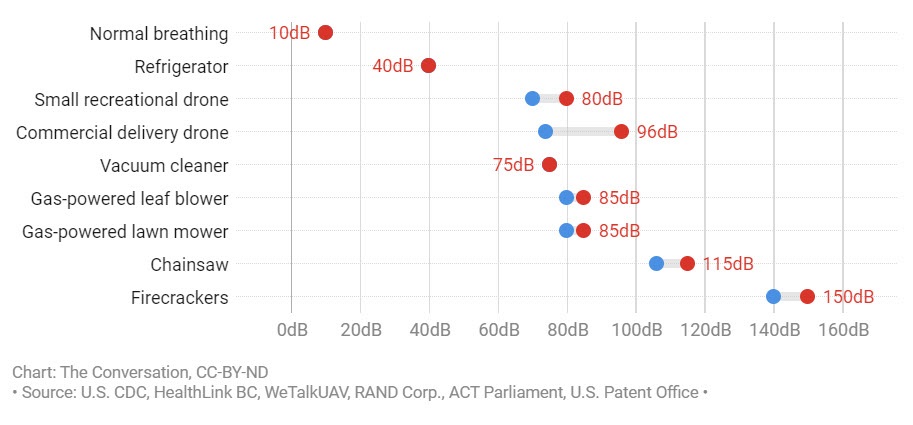
We will only accept drones in our proximity if they can blend with ambient noise levels. The picture below gives you an idea of what those are.
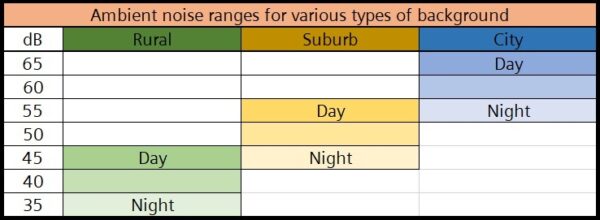
The bad news is, where it’s probably economically more viable to use drones as a replacement of other delivery methods (suburbs like Bonython), is generally where ambient noise levels are lower.
Set drone noise as a priority when defining flight trajectories
This leads us to the second variable in the acoustics equation: the noise path. When studying sound propagation in the open air, it is tempting to oversimplify and just consider the distance between drones and potential receivers. But more parameters play a role, including reflection/absorption on the ground/objects, diffraction, and atmospheric effects like the wind and temperature inversion. It is crucial to understand the influence of those parameters and to define, based on that, more conscientiously where drones can fly.
It will benefit operators if they show concern about noise when deciding on flight trajectories rather than just obeying regulations or making pure economic considerations. But to achieve this, they need to do in-depth acoustics analysis on the drone in its actual environment. That requires effort. But by doing so, by adapting flight routes accordingly and by using that information as a basis for transparent communication with residents, they can dramatically reduce both the noise itself as well as any friction regarding this topic before it escalates.
In parallel, as the Bonython case illustrated, a dedicated regulatory framework is necessary. Most currently available regulations are primarily inspired by safety concerns, for example, that drones cannot fly higher than a certain altitude or cannot be too close to people or airports. But rules that specifically target drone noise mitigation are rare. However, it is indispensable to have those in place before even thinking about the commercial exploitation of drones in the public space. Ideally, these rules have a universal basis. And how great would it be if they could at the same time be flexible, dynamic, and location-specific? For example, supported by a digital platform that allows on-the-spot prediction of noise impact. It’s just a thought.
Simcenter 3D Acoustics: the most comprehensive drone noise simulation software
All this acoustic engineering work will require proper tools. Meet Simcenter 3D Acoustics simulation software, the ideal partner for drone manufacturers, operators, and all other stakeholders who want to reduce drone noise. With Simcenter 3D Acoustics, engineers can accurately and efficiently simulate all drone noise aspects. In this way, they can study the root cause of problems, and analyze the effect of countermeasures, whether applied on the source or on the path.
Simcenter 3D Acoustics includes for each acoustic problem the right technology, and for every technology the most performant solver. The software combines this with an easy user interface, powerful postprocessing tools, and capabilities to parametrize and automate processes. Simcenter 3D Acoustics is an open software that can easily link to other tools, for example, to increase simulation accuracy, such as to Simcenter Testing solutions or to Simcenter STAR-CCM+ computational fluid dynamics (CFD) software.
Below, you can find the typical process steps for drone noise analysis. Note that having all these combined in one environment, is unique.
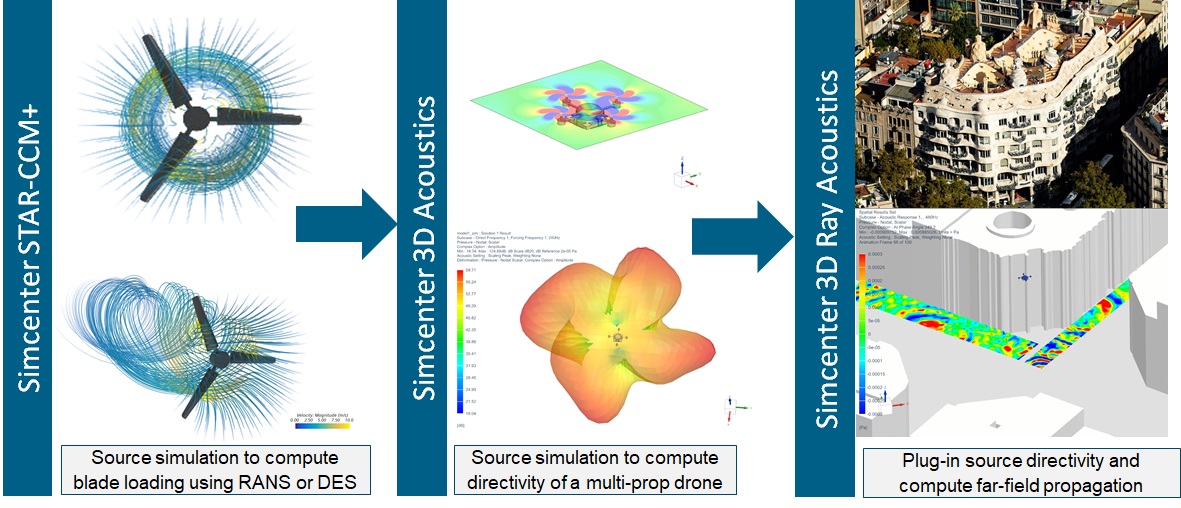
Capture the flow on the propeller blades and prepare drone analysis
Drone noise analysis starts by calculating the unsteady flow field around a propeller blade in Simcenter STAR-CCM+ software, using, for example, a Reynolds-Averaged Navier-Stokes (RANS) solver (or similar). After importing them into Simcenter 3D Acoustics, these CFD results can easily be converted, first into fan blade forces for all the propellers, and then into aeroacoustic sources.
Acoustic simulation of the drone itself
Those become part of the acoustic model of the drone. For this application, finite element analysis including automatically matched layer (AML) and finite element adaptive order (FEMAO) technologies, is currently the most performant approach. We already described the advantages of this method in an earlier blog.
In Simcenter 3D Acoustics, you can efficiently create the acoustic mesh starting from a CAD model of the assembled drone, add other boundary conditions if required, set up all the necessary parameters, and start the acoustic calculation for the desired frequency band.
This calculation helps drone manufacturers study for example the sound pressure levels at microphone positions or determine the directivity pattern. The latter is interesting when the result of this calculation is taken to further far-field analysis.
Simulate drone noise in a realistic environment
This can happen in Simcenter 3D Ray Acoustics for high-frequency and far-field acoustics analysis. This technology was already described in an earlier blog as well.
Using this tool, drone manufacturers, operators, and others can combine the directivity pattern of the drone with CAD data that represents the environment. After adding the necessary properties to the surfaces in the environment, they can make realistic studies of drone noise propagation.

Review the entire process in the snippet video below:
Epilogue: so, what’s next in Bonython?
Shortly after the trial, Wing received permission to operate in some northern suburbs of Canberra. They replaced their drones with quieter models though. But in Bonython, the service was abandoned.
‘The ACT assembly finally saw that drones aren’t different from planes when it comes to noise regulation,’ explains Sheather. ‘They should go through a similar approval process. And as this didn’t happen for the drones in Bonython, they were considered illegal. For us, the story ends here.’
At the beginning of this year, there were 8 commercial companies worldwide developing drone delivery systems and services. As it goes in such a sector, only the fittest will survive. Our guess is that those with quieter drones will have a better chance.
At Simcenter, we know we can help, and we hope we will get the chance to do so. Why? See below. This is also a Bonython resident. The video gives us mixed feelings. On the one hand, it painfully illustrates how deeply divided this neighborhood became. Yet on the other, it demonstrates the great potential of drone technology for this application.
Related blogs and other information:
Did you enjoy reading and want to know more? Then you might consider reading the following blog posts as well:
- How can the industry help reduce aircraft noise pollution?
- Towards safe and autonomous drones with COMP4DRONES
- Supporting the development of autonomous urban air mobility vehicles
- Will the next-generation aircraft meet the challenges of airworthiness certification?
Or why not take a look at this webinar: Accelerate VTOL aircraft verification and certification

